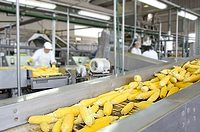When you think of food safety, sanitary design may not be the first thing that comes to mind. In fact, nothing at all may come to mind when you hear the words sanitary design spoken. And that validates the case that sanitary design—although tremendously beneficial for food processing facilities—is often an untapped element of food safety plans.
What is sanitary design exactly? By definition, sanitary design is the application of design techniques that allow the timely and effective cleaning of an entire food manufacturing outfit. Sanitary design helps to not only promote operational efficiency, but also protect the integrity of food products.
Furthermore, sanitary design can go hand and hand with pest management programs. Integrated pest management (IPM) is a proactive approach to pest management, relying on sanitation and facility maintenance to prevent infestations before they begin. When IPM is paired with sanitary design, the food safety plan is strengthened because of the valuable double-duty protection that is provided for the facility itself.
As you move into the end of the year, consider these key ways to revitalize your facility with processes and standards that align with sanitary design and IPM principles.
Air Circulation
Establishing proper ventilation and air flow at your facility is imperative. Without it, conducive conditions for condensation, odors and mold will be present, putting your products and staff members in a risky situation. What’s more, moisture attracts pests, which means a lack of appropriate ventilation in your building can give pests some of the resources they need to make a new home in your space.
To keep air circulation from fostering a hazardous situation, consider working with a maintenance professional to ensure your HVAC system keeps condensation on exposed surfaces to a minimum. The system should also decrease the intensity of heat, moisture and humidity inside your facility—all of which can pave the way for the growth and spread of pathogenic bacteria.
It’s also important to recognize that microclimates can exist within your facility. A microclimate occurs when humidity levels are not the same throughout every area of the facility. If a leak exists in one corner, the immediate air in that vicinity may have a higher humidity level than the rest of the air in the facility. Pests thrive in humid areas – in fact, when humidity gets to 50 percent or higher, pests can survive quite well without any food sources. For this reason, it’s important to pay special attention to microclimates.
For an added bonus, ask your maintenance professional to make sure that all air flows from inside of your building toward the exits. This air movement is called positive airflow, which helps prevent flying pest activity by constantly pushing the insects toward the outdoors and away from your products.
Equipment Positioning
Equipment and machinery that facility managers fit into tight spaces can easily contribute to sanitation difficulties: when equipment and machinery are placed this way, certain sections of the equipment can be concealed and unreachable. At that point, the sanitation team will have a tough time removing trapped food from and preventing bacteria growth on the equipment. Pests often become attracted to areas and surfaces with exposed food and grease or gunk buildup. And, if the sanitation team is unable to access these areas to clean, it’s probably safe to say that your pest management professional won’t be able to access them either when pest issues arise.
To optimize sanitation, sidestep the urge to squeeze equipment into close quarters and instead work with a pest management professional to set up all equipment in wide, open areas of your facility. This placement will allow your sanitation team to reach the spaces above, beneath and to the sides of your machinery without any obstacles, and keep pest attractants to a minimum.
Self-Draining Equipment
It can be relatively easy to spot liquid and product buildup on the manufacturing floor or other surfaces at your facility; however, when liquids and products collect inside equipment, it is not always apparent. To be as cautious as possible, consider upgrading your equipment to a version with a self-draining component whenever you can. By taking this precautionary step, you are assisting in the prevention of dangerous bacteria growth and buildup that can—again—attract pests like cockroaches to your facility. If you cannot yet upgrade to self-draining equipment, make sure your sanitation team checks the interiors of your machinery when possible to manually drain or remove the liquids and products that may have collected. Sometimes checking the interior of machinery can be tricky, but a skilled maintenance professional can help design ways to gain access. Remember, machinery that goes without cleaning doesn’t just attract pests to the facility, it attracts pest to take up home within the machinery itself.
Structure of the Facility
No matter how positive your airflow, how well-placed your machinery or how upgraded your equipment may be, the structure of the facility will play a major role in whether your sanitary design and pest management plans are effective. Newer facilities are strategically designed to prevent pests. However, old buildings and warehouses where many food manufacturing companies call home, especially those that have been converted into food manufacturing facilities and were not necessarily designed for that purpose, can undermine some of the positive gains from sanitary design. Work with an inspector and pest management professional to have your building assessed for areas of concern such as wall voids, ledges, cracks and crevices. These areas serve as potential harborage for dust, debris and moisture—all of which can be pest attractants. Additionally, ensure that any old sewer systems or drains that are no longer in use are properly plugged to prevent pests from using these areas as entry points. This assessment will not only identify ways to help keep your sanitary design efforts from being weakened, but also keep pests from finding a way inside your facility.
As you approach the end of the year, keep these sanitary design concepts at the forefront of your mind. Also remember that you’ll reap even more of the long-term benefits of sanitary design when paired with IPM, so don’t waste any time in consulting a professional to begin setting your new plans in motion.
Ron Harrison, Ph.D., is an entomologist and director of technical services for Orkin and an acknowledged leader in the field of pest management. He can be contacted at ronharrison@rollins.com; visit www.orkincommercial.com for more information.
Sanitary Design: An Often Untapped Element of Food Safety




